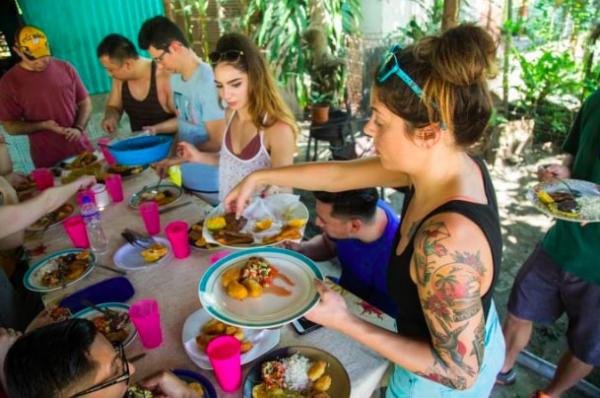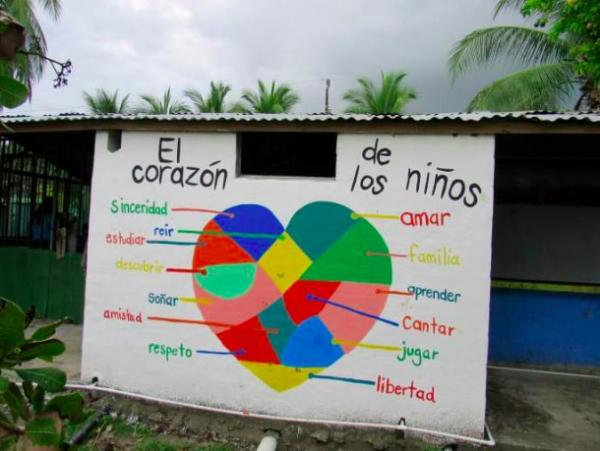Why We Stopped Going to Manuel Antonio National Park [Updated] We're Back!
Updated March 2, 2024 by Matt Wilson, CEO of Under30Experiences. He lived in Manuel Antonio, Costa Rica for many years and is very familiar with the sustainability issues of the region. Original article was drafted by Under30Experiences staff member Delphine Zebouloun.
According to Costa Rica’s National System of Conservation Areas (SINAC), Manuel Antonio National Park was created in 1972, “dedicated to conservation, research, and ecological tourism oriented towards environmental education.” It quickly became one of the most visited National Parks in Costa Rica.
But in 2018 we took a stand. Manuel Antonio National Park's sustainability practices were not up to our standards and there were some good reasons why we stopped including the park in our trip to this region.
What comes to your mind when you think of a National Park?
Beautiful landscapes. The sounds of wild animals around you. Cool hiking trails. Peace at last. You get it…
I bet you don’t think about raccoons opening up your backpack and stealing your lunch while you’re sunbathing. It sounds ridiculous, but it has happened to me and many other U30X travelers. And although it makes for a hilarious Instagram story, the underlying problem is not funny at all.
Visiting Manuel Antonio National Park was an included activity on our Costa Rica Trip until our team started thinking hard about the impact tourism has on the animals in the park.

We stopped going for two main reasons:
1. Negative impact on the wildlife
For many years tourists had been feeding the animals, especially monkeys, raccoons, and birds to attract the animals, and of course, for pictures. The Park Rangers were not attentive to this and what tourists don’t realize is that giving food to the animals has major consequences, as we always explain to our travelers.
Don't believe it? Read our article on why you shouldn't feed the monkeys on your trip to Costa Rica.
In 2015, the Costa Rican Newspaper, La Nación, reported on these consequences stating that, “The animals diets have changed, replacing fruits and leaves from the forest with cookies, crackers, sweets, and fruits containing high sugar levels”. This puts animals at risk of suffering from bone problems, obesity, diabetes, and tooth decay.
The animals in the park were becoming more and more aggressive and comfortable with human interaction, looking for food and many times preventing our groups from enjoying our lunch and walking down trails. Costa Rican Wildlife Laws strictly prohibits the feeding of wildlife but people don’t respect the law and it is causing damage to the wildlife in the park.
Other negative outcomes from feeding the wildlife include:
- The possibility of spreading diseases such as rabies and gastrointestinal problems between animals and humans.
- A dangerous dependency on humans that diminish the animal’s natural survival abilities.
- An interference with the animals’ natural habits and lifestyle centered around eating fruits, seeds, small animals, and insects.
There are several organizations in the Quepos-Manuel Antonio who dedicate time and effort into making sure people do not feed the monkeys including Kids Saving the Rainforest, The Titi Monkey Foundation, and The Sloth Institute.

2. Administration of the National Park
Manuel Antonio Park is one of the most visited parks in Costa Rica. A reported 450,000 visitors entered the park in 2017. The park’s website stated that the daily amount of visitors allowed in the park is 600 on weekdays and 800 on weekends. When you do the math, accounting for the park being closed Mondays, that’s an extra 228,466 tourists entering the park beyond the limits set on the park’s website! Something didn't not add up...
According to the Costa Rican newspapers La Nación, La Prensa Libre, and CRHoy, between 2009 and 2017, Manuel Antonio Park and the Ministry of Environment, Energy, and Telecommunications (MINAE) had to be criminally reported by the Ministry of Health. Here are a few of the complaints:
- Since 2014, there have been several complaints because the park didn’t comply with Law 7600 (Equal Opportunities Act for People with Disabilities).
- The plumbing in the park did not sustain the number of people who use the facilities, causing residual water containing fecal matter to flow into the ocean.
- One of the treatment systems collapsed in 2016 and the water inside was considered a potential breeding ground for mosquitoes that transmit diseases such as dengue, zika, and chikungunya.
- There were no protocols for the cleaning of tanks that store drinking water.
While the authorities are looking for solutions to the problems, overtourism continued to affect the infrastructure of the park and damages the fragile ecosystem.
The last reason we’ve stopped going to the Manuel Antonio National Park is that Under30Experiences Trip Leaders, pride themselvesselves on taking our travelers on the road less traveled. Staring at the same ball of fur 30 feet up in a tree next to 50 other tourists is anything but the road less traveled.
We want to show you the places you can’t discover on your own. The secret stuff that differentiates you from all the other tourists. The things that make you a traveler instead of a tourist...
But Here's Why We are Headed Back!

Luckily, thanks to pressure from local leaders, and investment from the Costa Rican government and the Inter-American Development Bank, the park has made huge improvements:
- Manuel Antonio National Park guides have been incredibly strict about food and check everyone's bag before entering.
- In 2023 the Costa Rican Constitutional Court has ruled to limit the number of visitors in the park to 1,200 people per day, down from 3,000 per day that was previously being enforced. Tickets are limited but we secure them in advance for our travelers!
- Major improvements to the bathrooms and sewage system have been made.
Manuel Antonio National Park is an incredible opportunity to see primary and secondary humid forest in Costa Rica. The park is home to two types of sloths, three types of monkeys, and tons of other creatures. And the beaches inside the national park are some of the most stunning in the world. No coolers allowed!

Check out our solo travel guide to Quepos and Manuel Antonio, Costa Rica!
How else are we supporting sustainability in this region?
For several years our goal has been to incorporate an included activity within each of our trips that can support a local community or support environmental sustainability efforts.
And guess what? This activity includes both. Like I said before, we are travelers and travelers give back!
So, we have started a community project on a small island near Manuel Antonio called El Cocal.

About the "El Cocal" Project
El Cocal is a humble island mostly inhabited by people who started migrating to Costa Rica in the 80's due to the social-political situation in the Central American countries and moved to Costa Rica for work and better quality of life.
The island's population is about 500 families or roughly 2,000 people, who are mostly engaged in traditional/subsistence fishing. Most of the immigrants that live in El Cocal moved and built their houses on this island because it was not inhabited by anyone. They didn’t have to pay for the land, taxes or constructions permissions, and now they have a home for their families.
Many of the immigrants on the island are from Nicaragua who moved to Costa Rica to look for better living conditions. According to minimum-wage.org the approximate national minimum wage in Nicaragua is about $2,218 per year while the Costa Rican yearly wage is $5,334 per year.
Currently, Nicaraguans are battling political unrest. As reported by the Nicaraguan Association for Human Rights (ANPDH), Nicaraguan President Daniel Ortega’s police and paramilitaries have killed 285 people, mostly students and other young protesters; but now families, children and innocent bystanders are among the dead. The Nicaraguans are demanding the president’s ouster and a return to democracy.
The reasons to leave Nicaragua are more than justified. According to the Mayor of Quepos, the inhabitants of El Cocal found the land many years ago and built their respective homes on it regardless of the very high social risk. The government does not provide electricity, trash pickup, or other basic amenities, because of the population’s vulnerability to natural disasters, and the municipality does not have enough resources to relocate them to a safer site.
The residents of El Cocal must rely on their ingenuity and resourcefulness due to the lack of government support for their community.

When you hop on the ferry and cross over to El Cocal, you get transported to a different side of Costa Rica. The people of El Cocal may have very little, but the community is rich in history and multiculturality: a vibrant mix between Nicaraguan, Costa Rican, and other Latin American cultures. The people who live on this small island want to support each other.
We met one Costa Rican woman, Anabelle, an anthropologist and resident of El Cocal, who is working with the youth and helping them retrace their unknown family history. If successful, there will be a huge family tree available for all of El Cocal to see with the residents’ respective roots.
We met directly with a community leader and convenience store owner, Giovanni, to discuss what Under30Experiences can do to support El Cocal. From what Giovanni tells us, the families in the neighborhood have a lot to offer, but little resources to execute their ambitions. We want to empower the El Cocal community to take care of their home and improve their situation.
How are we doing this? Here is the yummy part.

After multiple meetings, we have agreed on a project that will benefit not only the people of El Cocal but our travelers as well as part of a dynamic cultural activity.
Many different families from El Cocal have welcomed us into their neighborhood and offered to teach us how to cook delicious traditional food in their colorful Community Center-turned kitchen. Our budget spent at the National Park now creates a beautiful cultural exchange between our travelers and the kind community of El Cocal.
Part of the money we pay for the cooking class goes to the families that teach us how to cook and some goes to buy the groceries. The leftover money goes to the Community Center's fund to sponsor projects in the neighborhood like building a new park with exercise machines or helping a family affected by recent flooding.
We hope you welcome this new change with an open mind, as we have worked hard to make our itineraries more impactful for both the communities we are working in and for YOU.
--
Interested in taking part of the El Cocal Cooking Experience and visiting Manuel Antonio National Park? Join us in Costa Rica!

















.webp)
.webp)
.webp)





